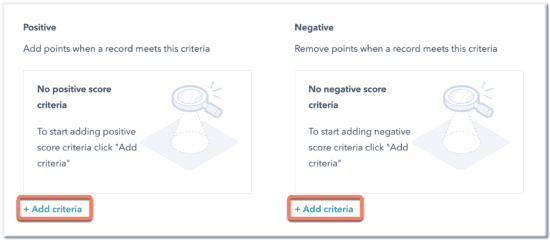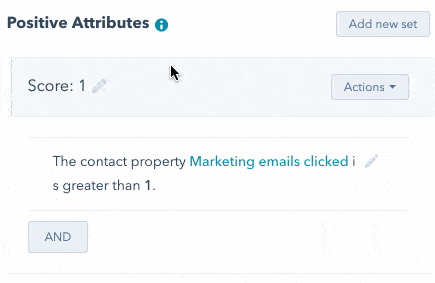Is your marketing team working hard to generate leads but your sales team is struggling to prioritise them? A healthy sales pipeline is the objective of any e-commerce business, but knowing how to rank leads according to their likelihood to convert can be a tricky process. Some prospects could be browsing your website to gather information about your product whereas others could be looking for the right deal to purchase now. But how can your sales team tell the difference?
HubSpot lead scoring is a powerful tool that enables you to sort your hottest leads from your coldest ones so that your sales team can focus on nurturing the leads most likely to convert and stop wasting time on those that won’t.
How does lead scoring work?
Lead scoring helps you determine the most common characteristics of your ideal customer so that you can assign a numerical value to those attributes and start to build a pool of hot leads for your sales team to follow up. 79% of marketing leads never convert to sales because they haven’t been nurtured (source: MarketingSherpa via HubSpot) so implementing a scoring system will help you filter your prospects and make your sales team more successful.
In our experience, there’s no standard approach to lead scoring as priorities differ for each individual client, but one of the most common ways to assign points is to use data from past leads to create a value system. You can start by looking at the most common traits of your customers, the attributes of your contacts who didn’t become customers, and the typical behaviour of a lead before it converts. Based on this information, you would then assign positive and negative points to each characteristic so your sales team knows which prospects to focus their efforts on.

What type of data should you target?
There are a number of attributes you could target with your lead scoring model. They could be demographic and based on the information you have collected about prospects including their age, geographic location, organisation type or job title. Demographic analysis will help you identify the traits that best fit your ideal customer profile so you can determine if the lead is a good fit for your product.
You could also target behavioural traits relating to how people interact with your web content, emails or ads. When you associate point values with sales-ready behaviours and actions, those values will grow as leads becomes more familiar with your product and move through the research phase of the buyer journey. Once those prospects reach the optimum threshold for their lead score range, you can pass them to the sales team to be followed up.
We recommend combining demographic and behavioural information to help you build a picture of each individual lead’s profile as well as their potential to convert to a sale. Following are just some of the criteria you could target in your lead scoring model.
Demographic information
- Location – where are the majority of your customers based? Identify the most common locations and allocate a score to leads in that location.
- Age – what age ranges are most and least likely to convert? Allocate negative scores to those who fall outside your target age range.
- Job title – if you’re a B2B organisation, you’re probably targeting certain job functions and levels of seniority so assign more points to traits which fit your ideal profile.
- Organisation size or type – again, if you’re a B2B or B2C company, you’ll want to want to allocate more points to organisations of the size and type you want to do business with.
Behavioural criteria
- Page views – which pages are typically visited before a lead converts to a sale? Are there any blog posts that contacts are finding particularly useful which should be given more weight in your scoring system?
- Email interaction – click-through and open rates can indicate the level of interest in your product and overall engagement levels. Deduct points if the contact has not opened or clicked your emails within a certain period.
- Unsubscribed contacts – if someone has opted out of your email marketing, they are unlikely to be interested in your product (perhaps they subscribed in error or have since fulfilled their buying need elsewhere) so you can allocate a negative score to those contacts.
- social engagement – if someone is engaging with your social content, it can be a good indication of how interested they are in your product so you should allocate a score to that activity accordingly.
- form submissions and downloads – assign more points to contacts who complete high-value forms such as a product demo request, or who download sales-ready content such as a free trial or coupon.
How do you know what data matters most?
To help you identify the most common traits of your customers, take a look at Google Analytics or your HubSpot data, in particular the page performance and attribution reports. What content are people looking at before they become a lead or customer?
HubSpot campaign reports show you how much revenue has been generated as a result of specific marketing activities including downloads, email campaigns, form submissions and call to action (CTA) click-throughs. Review which activities are yielding the most revenue and then assign points accordingly.
For one ecommerce client, campaign reporting showed us that a customer survey generated an impressive 43% of influenced revenue in Q1 2022 – the most influenced revenue of all non-seasonal campaigns so far this year. We instantly knew this campaign should be assigned a high score as respondents are clearly engaged and therefore ideal to be nurtured via lead scoring.
After your data analysis, you should speak to your sales team to determine their interpretation of a good lead. After all, they’re the ones having a conversation with prospects and converting them to customers, so they’re most likely to know anecdotally which pieces of content resonate best.
Finally, you should conduct interviews with customers to get their take on the sales process. Was there was any content that influenced their decision to purchase from you? Examine their past behaviour in the CRM to identify any patterns in activity such as common page views or form submissions to which you can allocate more points.
Automated campaigns to target your lead-scored contacts
Once you have built your lead scoring property in HubSpot, you can then assign points to your contacts and start to design a follow-up strategy for your sales team. HubSpot automations are an ideal way to nurture your leads towards becoming MQLs (Marketing Qualified Leads), SQLs (Sales Qualified Leads) or whatever lifecycle stage you intend to target with your campaigns.

Below are some examples of the types of lead scoring campaigns you can create using HubSpot workflows.
Email marketing campaigns
Once a contact reaches a certain lead scoring range, use HubSpot workflow functionality to email useful information about your product to suit the contact’s lifecycle stage.
Some of the campaigns we’ve set up for clients include a series of informative emails to educate subscribers and leads about how their product can solve the user’s problem with a view to converting those leads to MQLs. We are also developing a referral scheme for another client to incentivise their top fans to spread the word about their company to friends and family. To encourage one-off purchasers to become repeat customers, we are emailing those contacts an exclusive discount code to encourage a repeat purchase. As contacts engage with each email, they are assigned more points so that they can be identified as good targets to be followed up by the sales team.
According to Marketo, targeting users with content relevant to their position along the buying process yields 72% higher conversion rates, so devising a follow-up strategy based on the customer lifecycle stage will yield positive results for your business.
Paid search and social advertising campaigns
Complement the messaging of your email campaigns with a series of paid social and search ads. Using HubSpot lists, you can target customers based on the same demographics as your email campaigns, helping to reinforce your messaging and build brand awareness.
Sales-ready data for one-to-one follow-ups
Lead scoring enables you to prioritise your hottest leads, so once contacts hit a certain threshold in your lead scoring model and are therefore closer to a conversion, you can set up automated tasks to notify the sales team to follow up those leads with a sales call. The personal touch of a telephone conversation to determine if there is anything further you can do to help the prospect could differentiate you from the competition and result in the sale you’re looking for.
What are the benefits of lead scoring?
There are many benefits of a lead scoring system, but we have identified our top four below.
Increased productivity
Lead scoring means your sales team can stop wasting time cold-calling contacts who are not interested in your product and instead concentrate their efforts on following up hot leads who are already engaged with your brand and service. HubSpot workflows enable you to automate sales tasks for your team so they don’t need to worry about scheduling follow-ups or forget important deadlines, resulting in more efficient processes and increased productivity.
Higher ROI
When your sales process is more efficient, teams can prioritise the best leads and use workflows to automate tasks and follow-ups. This means your teams are more productive so you will spend less time on processes and generate more profit, leading to higher ROI.
Lead scoring also helps you identify other ways to save money. For example, we have implemented a lead scoring system for a client which is now enabling them to identify unengaged and unsubscribed contacts that they can set to non-marketing status on an ongoing basis. This means they are only paying for the most engaged contacts in their CRM, and are being charged 60% less for their contact storage as a result.
Better conversion rates
Lead scoring enables you to identify leads that are more likely to convert so that your sales team can nurture those better-quality leads. Once the prospect has spoken to your sales team, they will be familiar with your brand and better educated about your product, which will facilitate their decision-making and make them more likely to choose your brand over the competition.
Align your sales and marketing teams
When your sales and marketing teams are working towards a common goal, it is easier to develop a collaborative approach to your marketing efforts. Sales people can tell marketers what content is indicative of purchase intent, and marketers can use this information to make adjustments to their collateral to continue attracting better leads.
Get in touch today
Are you struggling to identify your best leads? Would you like to achieve efficiencies for your sales team? Then HubSpot lead scoring could provide the help you need. Attacat are experts in delivering lead scoring strategies that will drive revenue for your business. Book a meeting with us today.
